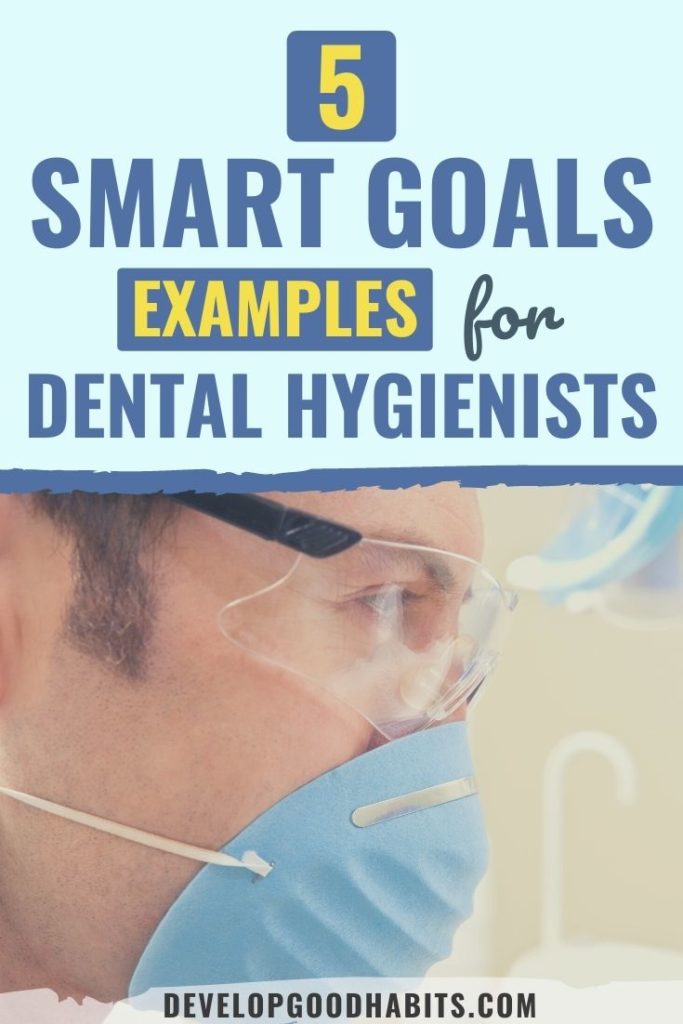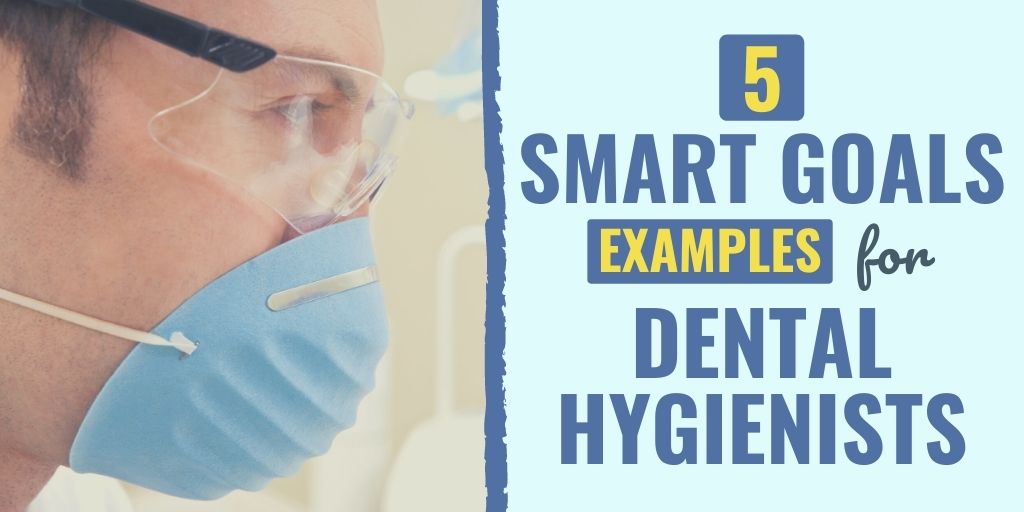Dental hygiene is a fantastic career, but there will be challenges you will face as a dental hygienist in your practice. These challenges include physical issues, dealing with patients, maintaining organization, mental strain, and advancing in the dentistry field, among others.
As a dental hygienist, you can set goals to overcome these obstacles. Here we are talking about SMART goals for dental hygienists. SMART goals are specific types of goals designed to narrow the focus of a particular goal.
SMART goals allow you to stay organized and motivated. They allow you to hammer out how to achieve a goal, measure your progress, and state when this goal should be achieved. Let’s look at 5 SMART goals to help you become a better dental hygienist.
What Are SMART Goals?
Before we can give you examples of SMART goals, you need to know what they are. SMART goals are a specific way of setting your goals, with each of the five letters of SMART standing for a particular goal-setting aspect.
SMART stands for Specific, Measurable, Attainable, Relevant, and Time-Bound. If followed when setting goals, these five aspects will enable you to achieve them faster and easier. These are the five components of SMART goals.
If you would like a more in-depth explanation of these SMART goals, we recommend checking out this Ultimate Guide to SMART goals.
Why Are SMART Goals Important for Dental Hygienists?
SMART goals are essential for dental hygienists because they face many challenges in their careers. The best way to overcome any challenge is by setting goals, and the best goals are always SMART goals.
Finding a job as a dental hygienist can be a challenge. But then, for those who want to become a dentist, engaging in further studies can be challenging as well.
Dental hygienists face physical challenges in the long hours of standing that can be taxing on the back, legs, and feet. Moreover, handling dental instruments can cause strain on the forearms, wrists, and fingers. Physical pain exists in dental hygiene and not just for the patients.
Speaking of patients, perhaps one of the biggest challenges this profession faces is the patient, who can sometimes be challenging and uncooperative. Learning how to deal with people is essential for success and your sanity.
Yet another challenge faced by dental hygienists is being able to relax and decompress and keep your cool during heated moments. Patients aren’t always easy to deal with, and you cannot let them affect your mental well-being.

Even just finding the time to perform all the necessary tasks for a patient can be time-consuming. Taking vitals, discussing medical history, cleaning teeth, and checking gums all need to be done. Excellent organization and a concise plan of attack for each patient are therefore crucial.
Whether dealing with physical pain or difficult patients, setting SMART goals can help you overcome these problems.
A SMART goal outlines your end goal, how and when to get there, and how to measure your progress. A SMART goal is your plan of attack for achieving one more significant goal.
5 Examples of SMART Goals for Dental Hygienists
We will look at a few examples of SMART goals for dental hygienists. Then, we’ll tackle sample problems or challenges as discussed above.
1. As a beginning dental hygienist, my goal is to apply to at least one new dental hygienist position per day. I will use all possible application methods, whether online or in person. My end goal is to secure a spot as a dental hygienist as soon as possible.
S: This goal is specific—to get a position as a dental hygienist as soon as possible by using all possible job search and application methods.
M: This goal is measurable by tracking the number of applications completed per day and when a job has been attained.
A: This is a reasonable goal, as the point is to find a position that should be doable with proper dental hygienist education and training.
R: This goal is relevant because it pertains directly to having a job as a dental hygienist.
T: This goal is time-bound, as the aim is to find a position as a dental hygienist as soon as possible. The deadline is now.
2. My goal is to engage in various practices to decrease my level of physical pain and discomfort during my duties. I will aim to reduce my perceived amount of pain by at least 5% per week, every week until I no longer feel pain (or feel minimal pain). I will use all methods possible, including proper dental instrument handling, proper body mechanics stretching, yoga, physical therapy, etc.
S: This goal is specific—to decrease physical pain through the methods listed in the goal statement.
M: This goal is measurable to a certain degree as you cannot measure it with precise metrics, but you can measure your perceived amount of physical pain.
A: This goal is attainable, as setting aside a few minutes a day for stretching and other healthy activities are doable.
R: This goal is relevant, as decreasing your physical pain will allow you to be a more effective dental hygienist for a more extended period.
T: This goal is time-bound, as you aim to decrease your physical pain by a certain amount every week.
3. My goal is to engage in at least 30 minutes of relaxation per day, preferably in the evening. I will use various relaxation techniques, including yoga, meditation, hot baths, and other methods. My goal is to significantly reduce the perceived stress that I feel over several weeks. Within six weeks of starting my relaxation techniques, the end goal is to be totally stress-free or as close as possible.
S: This goal is specific—reducing stress over a particular time frame by using various stress management techniques listed above.
M: This goal is measurable to a certain degree. Although not numerically measurable, you can judge how much stress you feel. This is subjective, although still perceptively measurable.
A: This goal is attainable, as the stress management techniques discussed above are proven to work.
R: This goal is relevant because having too much stress will affect your overall performance as a dental hygienist.
T: This goal is time-bound, as the aim is to reduce stress as soon as possible.
4. My goal is to take communications and conflict resolution courses. My goal is to take these courses as soon as possible and get a grade of at least 90% in both classes. The overall goal is to reduce or totally eliminate instances of patient conflict. Ideally, the goal is to have no conflicts with patients by the time I have completed these courses.
S: The goal is to eliminate conflicts with patients by the time the conflict resolution courses are finished.
M: This goal is measurable on two fronts: by the grade you get in the course, as well as by the number of daily, weekly, or monthly conflicts that occur with patients.
A: This goal is attainable and realistic, as conflict management and resolution are parts of everyday life.
R: This goal is relevant because to retain customers in a dental practice, the customers need to be happy with you.
T: This goal is time-bound—to eliminate conflicts by the end of the conflict resolution course, or realistically, as soon as possible.
5. My goal is to ensure that I am well-organized so I can take care of all necessary tasks for individual patients. For example, I will organize all my tools before a patient gets there, take a patient history, and complete X-rays, tooth cleaning, and gum examinations within each patient's allotted time per visit. In addition, I will organize and budget my time by creating a triage list of the most necessary tasks and how long each should take.
S: This goal is specific—it refers to allocating specific amounts of time to complete tasks related to a visit to the dentist.
M: This goal is measurable by examining how many of the necessary tasks were completed in the allotted time and how well they were completed.
A: This goal is attainable, as this is what an excellent dental hygienist should be doing in the first place.
R: This goal is relevant because you must provide patients with the necessary services you are tasked to do.
T: This goal is time-bound—to complete all necessary tasks in the time you have the patient for.
Final Thoughts on SMART Goals for Dental Hygienists
Creating SMART goals should be a priority for you as a dental hygienist. With the right SMART goals, you can overcome the challenges you face as a dental hygienist, as laid out above.
It all starts with determining the actual goal, how to accomplish that goal, measuring progress, and setting a time frame in which the goal should be achieved. If you are dealing with challenges, SMART goals are the way to go.
And if you want more SMART goal ideas and examples for other professions, be sure to check out these blog posts:
- 5 SMART Goals Examples for Maintenance Workers
- 5 SMART Goals Examples for Risk Management
- 5 SMART Goals Examples for Security Officers
Finally, if you want to take your goal-setting efforts to the next level, check out this FREE printable worksheet and a step-by-step process that will help you set effective SMART goals.


